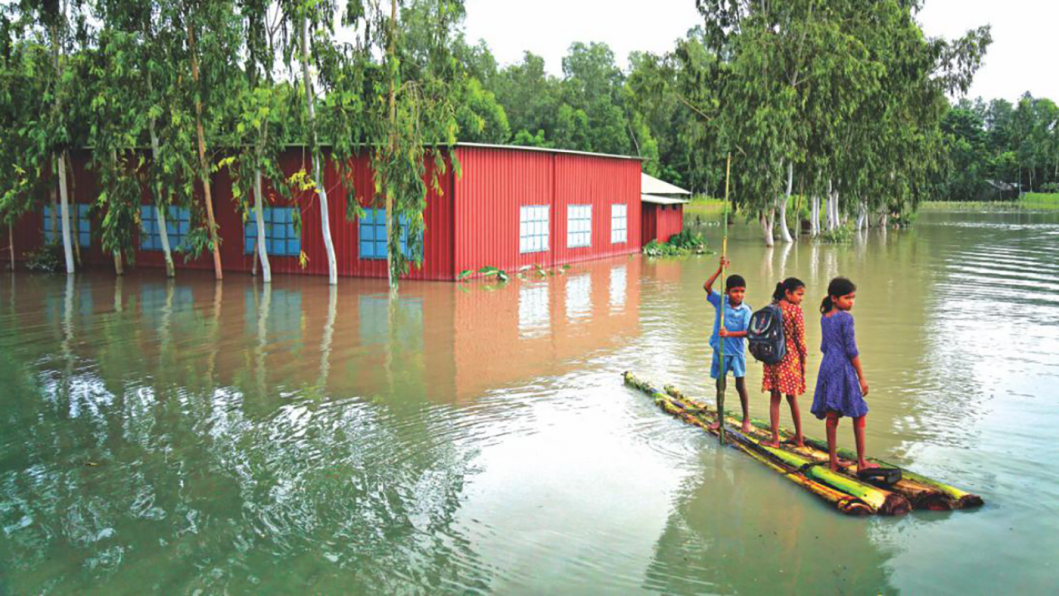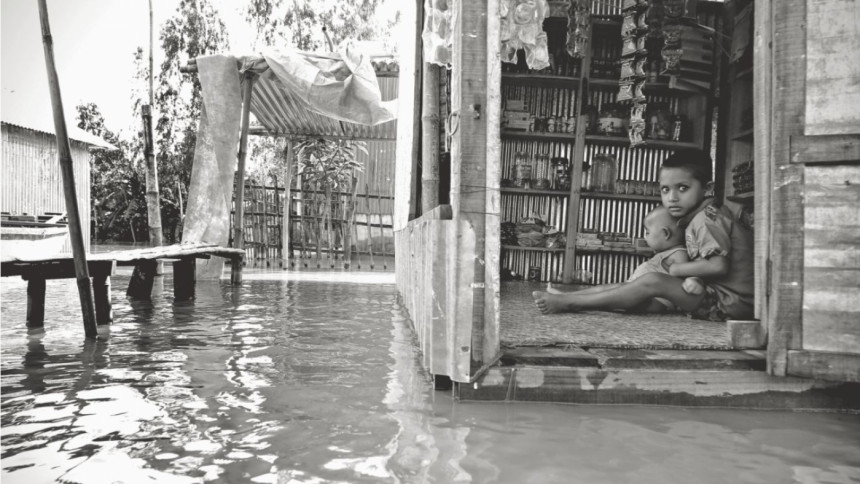Swallowed by the river

A flood is a familiar drill for Anwar Hossain. He can't keep track of how many times he has dismantled and moved his house. Of the millions who live on the riverine islands, or chars, in the Jamuna, no one lives in one place for more than a few years. If a bad flood doesn't wash away their home, the river swallows up the land it's on sooner or later.
So when the river rose to his doorstep in the end of July, Anwar was unfazed. Every home is prepared with dry food, and extra bamboo to raise their beds and other surfaces for when the waters rise. Nets and ropes allow them to hang their possessions out of the water's reach. When the waters retreated from his uthan, Anwar thought he had been spared the inconvenience of floods for the year.
But in August, the waters were back. "In the afternoon, there was three feet of water," says Anwar. Usually the waters come gradually over three to four days. So he estimated the waters would rise 18–20 inches at most that night—not enough to submerge the bed. What followed, Anwar likens to Qiyamat, the Day of Judgement.

Anwar's home, at the water's edge, was one of the first to be submerged. Where the water level might usually rise two feet overnight, on the evening of August 10, the water surged by five feet or more, something Anwar and his neighbours say they have never seen in their lives. The current swept away Anwar's entire house, with the precautionary items still unused.
Usually during a flood, people count on their better-off neighbours for a degree of assistance in rounding up their possessions and dismantling their house. But this time everyone was scrambling to save themselves.
Anwar managed to get his family of seven onto a small fishing boat and took them to a nearby plinth (a raised, flood-resistant area), constructed by Friendship, an NGO, in 2013. But this being the only higher ground in the Kheyar Alga char in Kurigram, it was already teeming with families and their livestock from miles around.
Anwar put up his elderly mother at the plinth, but the rest of the family huddled in the boat with only a polythene sheet over their heads to protect them from the incessant rain. To use latrines, they had to come to the plinth by boat or make do without. The family spent 15 days in these conditions. They lived on chira muri and rice, distributed as immediate relief by the government and NGOs working in the area, but only for three days into the floods.
Earlier, Anwar managed to take his main income source—his seven cows—to the plinth. When the waters started rising, Anwar was able to salvage the roof of his house but not his fencing from being washed away. He also lost his entire paddy crop and most of his household possessions. "How could I save my things if I myself was in danger of being washed away?" asks Anwar.
The floods this year inundated a third of the country, devastating the northern and central districts. The International Federation of the Red Cross and Red Crescent (IFRC) called the flooding "the most serious in 40 years". Up to 700,000 homes have been damaged or destroyed.

"This flood was worse than the one in 1988," says Anwar. Kurigram was among the worst affected districts, lying as it does at the junction of three major rivers—Jamuna, Teesta and Dharla. Heavy rainfall over several days and the onrush of water from upstream, where India had opened 54 gates of the Gajaldoba barrage, led to the rivers swelling dangerously. At least 12 people have died in Kurigram as a direct result of the August floods.
Since the floodwaters receded, Anwar has had to sell off five of his cows, one by one. He is at a loss as to what to do to eke out a living now. Earlier, he worked on other people's land for a 50-50 share of the crop. "Farming is what we know. Even if we don't own land, we work on others'. I'm illiterate, I don't have the ability to go do a job in town," says Anwar.
The government and NGOs rushed to deliver food aid to victims of the floods, but efforts to rehabilitate those who have lost their livelihoods are few and far between.
"Government response to flood damages in char areas is limited, as they are hard pressed to provide rehabilitation support to all those on the mainland itself," says Abdus Salam Jakir, Union Parishad Chairman of Kamarjani union in Gaibandha. He says that of the 976 flood-impacted households in his union, the government only provided a bundle of tin (sheets of corrugated iron) and BDT 3000 each for re-building to 15 households, after accounting for transport costs from the mainland.
"Rehabilitation requires a holistic year-round effort, due to the lack of permanent infrastructure on the chars," says Ahmed Toufiqur Rahman, Head of Good Governance at Friendship. Disconnected in their remote chars, people often have difficulty accessing government safety nets and support they're entitled to in reconstructing their homes in the aftermath of floods, he explains. "For post-disaster management and relief, there is a need to tailor programmes specifically to the chars," states Rahman.

Navigating the river
Right now, the water level is still high—it will drop some 10–15 feet over the next three months before the dry season. There is a char in sight in every direction.
Older chars are distinguished by taller, denser eucalyptus trees (ubiquitous on the chars as they grow fast) and more settlements and cattle grazing. Jute, used to make fences and rope, dry in tepee-like arrangements. Newer chars are tiny islets where there are no trees, only kashful swaying in the wind.
The geography of the chars makes it difficult for both NGOs and the government to function effectively there. For one, they are constantly changing. Equally important, transport to and from chars, particularly those that are out in the middle of the river, is time-consuming and difficult.
Boats are the mainstay of the char residents. Mostly motor-powered trawlers ply the waters, but you still see the occasional boat row by with colourful sails. At each char, people carry umbrellas against the unforgiving sun while waiting for the boats to do everything from going to the market to visiting the doctor. If they miss the boat for the day, it's a day wasted for them.
Keeping children in school is difficult all year, not just during the floods. Alpona, 30, is a mother of four from Kheyar Alga. There is no high school on the char. One of her boys attends school in Jatrapur, a large char connected to the mainland. From Kheyar Alga, schoolchildren have to walk a distance of 30 minutes and then take an hour's boat ride to reach Jatrapur.
Post-flood, this journey can be undertaken by boat alone. But the school is still closed as it is difficult for children to cross the river. If the schoolchildren miss the regular boat going by the char on that route, for which they would usually pay BDT 10 each way, they would need to pay up to BDT 100 round trip for boat fare to attend school that day. Though the floodwaters have receded, children remain out of the classroom.
Boats become the centre of the rescue effort during the floods. Households going under water were desperately seeking boats to get to higher ground.
In Kheyar Alga, many turned to young Jahurul Islam for help. His house on the plinth sheltered Alpona's family, among many others, on an emergency basis while the floodwaters remained high. Roughly half of the population of the char had taken shelter on the plinth during this time. Jahurul himself had to kip on a small boat while entire families packed his small house.
Char dwellers are used to seeking help from Jahurul, a Friendship-trained paralegal from the area. Jahurul also helped arrange for boats. "People contacted me to find out if any boats were available and to ask the owners to send these to evacuate those going under," he says. There are only seven large boats on the char, according to Jahurul, which are used to help evacuate char dwellers and livestock in emergencies. The rest, like Anwar, had to rely on small fishing boats.
Alpona had contacted her neighbour beforehand about using their boat when in need. "When we are in trouble during the floods, wealthier people with big boats help us out. They help regardless of whether we pay them then or not," asserts Alpona.

Here today, gone tomorrow
During the worst of the flooding between August 14 and 16, Alpona was forced to shift her family and whatever she could carry from her house to the plinth. Half of her home was later washed away in the current. Her family of six is now living in a small shack on another's land on the plinth.
But Alpona's state was not always this precarious. Her husband was a farmer with a relatively large house and land which they would lease to sharecroppers like Anwar. But the river encroached on their land and the floods inundated the rest.
Alpona's husband does nothing since he lost all his land. Like Anwar, faced with the loss of livelihood, he has been unable to cope. The only income in the family comes from their eldest son, 18, who works as a day labourer digging and raising land for houses.
Alpona is weighed down by the need to make more permanent living arrangements on lower land like before, once the waters recede. But this too, will probably prove short-lived as the char people are habituated to constant drifting. "I've moved a lot in my life, at least 10 times in this area alone, for either flood or erosion. In one year, I moved house three times. But this time, I've been affected the most," states Alpona.
The flooding in mid-August not only saw unprecedented levels of water and strong currents, but for the first time anyone can remember, the mainland was also badly flooded, catching residents completely unawares.
Ayub Ali Sarkar, Union Parishad Chairman of Jatrapur, Kurigram, points to the faded lines on the walls in his office, showing how it was flooded hip-deep inside. "The people of this area are not used to floods in the sense that their harvest is usually affected but homes are not really damaged in this way," explains Sarkar.
A government shelter in Kheyar Alga lies in ruins after it was severely damaged in an ordinary storm soon after being built. It is still in that state, with roofs missing and walls broken. Some families have nevertheless taken up shelter there with nowhere else to go.
Floods of the future
A month after the floods, many families continue to live on the plinth in Kheyar Alga and other shelters. Many of them have lost their homes and the land on which they once stood. In the coming months, local government officials, village elders and the influential will be gathering to decide on who will be given khas land and how the rest will be assisted.
The people of the chars have long since adapted to the floods every year. But the suddenness and strength of the waters this year took them by surprise and denied them precious hours to take the necessary precautions to secure their home and possessions and flee to higher ground.
Will this be the nature of future floods? Char communities will be particularly vulnerable to sudden flooding, because a system to cope is yet to be adapted. Their livelihoods and very existence, precarious enough as it is in the temporary char lands, are at stake.


 For all latest news, follow The Daily Star's Google News channel.
For all latest news, follow The Daily Star's Google News channel. 



Comments